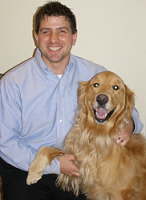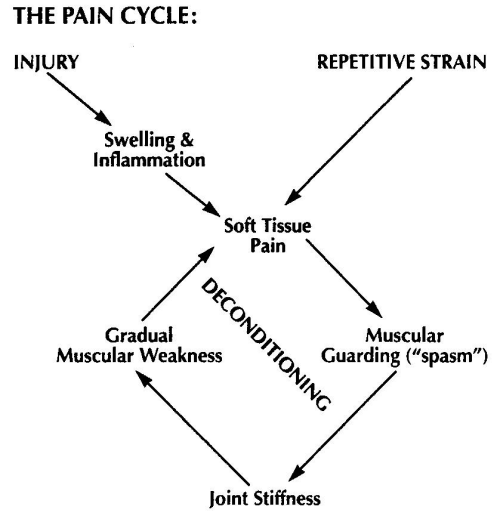I've Fallen and I Can't Get Up!
by Dr Jim Hendricks, Freeport Integrated Health Center, Freeport, Maine Ok, I could not resist using the line, but actually it should have read, "I've bent over and I can't get up." I have heard it many times before, "I just bent over to tie my shoes," or "I bent over the sink to brush my teeth." So how does such a simple maneuver cause such pain and a muscle spasm? Well, it begins with a previous/old injury, is compounded by repetitive motion/stress and is aided by de-conditioning (being weak or out of shape).
Ok, I could not resist using the line, but actually it should have read, "I've bent over and I can't get up." I have heard it many times before, "I just bent over to tie my shoes," or "I bent over the sink to brush my teeth." So how does such a simple maneuver cause such pain and a muscle spasm? Well, it begins with a previous/old injury, is compounded by repetitive motion/stress and is aided by de-conditioning (being weak or out of shape).
Statistics reveal that low back pain will affect approximately 80% of adults some time in their lives. So odds are that that as reading this you are thinking about the time you spend suffering from pain. I believe that most minor occurrences of low back pain can be avoided with proper body mechanics and exercise. However, once you have had an episode of pain it is important to treat the injury, no matter how minor, and then prevent it from reoccurring.
The low back or lumbar spine is composed of the last 5 vertebrae of the spine, named L1-L5 according. The vertebrae are connected by facet joints which are attached together through ligaments with an intervertebral disc in-between each vertebrae. The disc provides a gel-like cushion that helps to absorb pressure, distribute stress, and keep the vertebrae from grinding against each other. The vertebrae and discs are held together by groups of ligaments. Ligaments connect bone to bone, where as tendons connect muscle to bone. In the spine, tendons connect muscles to the vertebrae and ligaments and tendons help to stabilize the spine and guard against excessive movement in any one direction.
In the center of the spinal column is a hole called the spinal canal, which contains the spinal cord. The vertebral bones that create the spinal canal serve as protection to protect the spinal cord from injury. Spinal nerve roots branch off from the spinal cord through spaces between each vertebra and extend out into the entire body.
The there are over 30 muscles of the back, which are divided into 3 layers from superficial to deep. In the lumbar spine the muscles can be divided into three groups according to function: extensors, flexors and obliques. The extensor muscles are attached to the back of the spine and enable standing, lifting and arching the back. The flexor muscles are attached to the front of the spine and enable forward and lifting. The oblique muscles are attached to the sides of the spine and help rotate the spine and maintain posture.
Many things can cause low back pain but in my experience it is typically the following that contribute to it: injury, repetitive motion/lifting, weakness or stress. An injury to the facet joints of the spine cause them to become inflamed and the large back muscles can spasm and cause low back pain. Low back pain that lasts for 10 days or more can lead to muscle weakness and eventually disuse atrophy (muscle wasting).
Stress of any kind results in a fight or flight response in the body, which causes the muscle of the back to continually tighten, depriving muscles of energy needed to support the spine. This leads to muscle weakness and back pain.
Prolonged stress, pain, inflammation and repetitive injury can lead to a continual "cycle of pain" (see figure). De-conditioning is a normal part of this cycle. With it comes greater susceptibility to postural (bending over to brush teeth) or occupational stress (sitting for prolonged periods of time). In order to break this cycle, one must first progress through the acute injury stage and then re-train and strengthen the injured area to maintain a pain free and healthy status. If the area is not retrained then a pattern of chronic reoccurring pain can easily be established.
The 3 stages of soft tissue healing are inflammation, repair and remodeling. Inflammatory stage last up to 3 days and is characterized by pain, redness and swelling. Towards the end of the inflammation stage scar tissue and adhesions begin to form. The body reacts to tissue damage by laying down these connective tissues to help strengthen the area. However, if the inflammatory reaction is not curtailed these tissues can become fibrous. That is why it is extremely important to immediately apply ice to an injured area. During the repair phase the swelling usually has subsided and tissue repair begins. Scar tissue formation and adhesions continue to form. In the tissue remodeling phase the body gets rid of tissues adhesions and scar tissue.
After any acute injury especially to the low back, it is important to pursue the appropriate treatment. Too often I have heard this phrase, "I thought it would just go away." More often than not if you treat the acute injury aggressively and before it begins to worsen, then the healing period is greatly reduced.
I initially treat low back pain/injury with physio-therapy modalities (electrical stimulation/ultrasound and ice/heat), spinal manipulation and therapeutic exercise. The physio-therapy modalities and spinal manipulation help decrease pain and restore normal joint motion/mechanics. As the patient progresses out of the acute injury phase, rehabilitative strengthen exercises are implemented into the treatment plan to re-strengthen the area. Patients who continue their exercises after treatment ends usually have less frequent and less severe episodes of back pain in the future.

Dr. Jim Hendricks is a doctor of chiropractic at Freeport Integrated Health Center in Freeport. His undergraduate education is in Sports Medicine and he is Certified Strength and Conditioning Coach. For more information go to https://www.freeport-chiro.com/
Herb's Tips and More
-
 Did you know that you can make soap, candles and lotion with your herbs?
Did you know that you can make soap, candles and lotion with your herbs? -
 Never take any herb identity for granted. The best way to be sure that you are using the right kind of herb is by buying it.
Never take any herb identity for granted. The best way to be sure that you are using the right kind of herb is by buying it. -
 Excellent health articles whether you are looking for information or inspiration regarding preventive health or are dealing with a medical
challenge.
Excellent health articles whether you are looking for information or inspiration regarding preventive health or are dealing with a medical
challenge.









